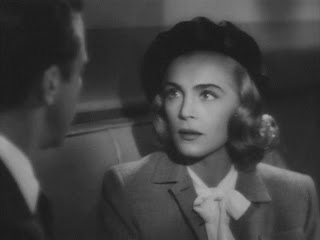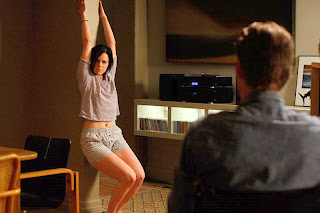 CRISS CROSS (1949)
CRISS CROSS (1949): "This under-rated, fatalistic film noir featured unreliable characters, tenuous relationships, a diabolical and fatal love triangle, and twisting plots. It was told with flashbacks and a self-deluding voice-over narration.
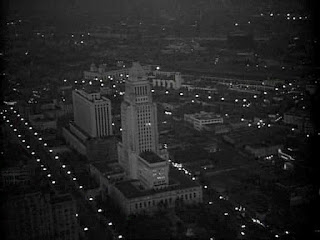
The film opened with a striking aerial panoramic view of nighttime Los Angeles before the camera swooped down to a parking lot where a doomed couple's embrace was revealed by glaring headlights. It told how love-sick, still-obsessed and infatuated ex-husband Steve Thompson (Burt Lancaster) returned to his LA family two years after a 7-month marriage to calculating femme fatale Anna Dundee (Yvonne De Carlo).

He was again snared into her web in the Round-Up nightclub, when he saw his ex-wife dancing the rhumba (to the tune "Jungle Fantasy") with an unnamed partner (an unbilled Tony Curtis in his screen debut). Afterwards, they rekindled their love when they took a swim in the early morning at Zuma Beach.

Dan Duryea as Slim Dundee in "Criss Cross" (1949) directed by Robert Siodmak
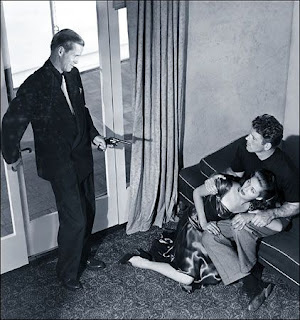
Dan Duryea threatens lovers Burt Lancaster and Yvonne De Carlo in ''Criss Cross'' (1949), script by Daniel Fuchs and William Bowers, based on a novel by Don Tracy.

Steve was warned to stay away from the temptress by his mother (Edna Holland). LAPD Lt. Pete Ramirez (Stephen McNally) also pressured Anna to leave town, when Anna suddenly eloped to marry abusive, crooked gangster boyfriend Slim Dundee (Dan Duryea). Nonetheless, Steve met up with her again and engaged in a clandestine affair.

Steve was expecting to double-cross Slim and escape with Anna, but he was himself double-crossed by Slim and horribly beaten up. Anna also planned to run off with her share of the loot".
Source: www.filmsite.org

CRISS CROSS -Universal, 1949. "I used to think there was something missing at the core. But it keeps getting better ever time I see it. De Carlo in the parking lot pleading straight to the camera might be noir's defining moment".
Source: www.eddiemuller.com

Robert Siodmak directs Yvonne De Carlo and Burt Lancaster in a scene from "Criss Cross" (1949)

"This is an unreal, unstable world of impractical passageways and precipitious drops; like the uneven terrain of the Bunker Hill area, "old town, lost town, shabby town, crook town", as Raymond Chandler described it, nicely used in one scene where Anna, wearing a summer dress and clunky platform shoes, must negotiate to steep approach to Steve's house.

In one masterly summary, the director articulates Steve's undoing: like so many Siodmak protagonists, Steve is as much attracted to beauty as hopelessly impaled on it.

Burt Lancaster was unhappy anyway (he was contractually obliged to finish the film). He later said he disliked that Siodmak had shifted attention away from his character to Dan Duryea's (really the attention shifted to a complicated romantic triangle).

The fatal romantic triangle is far more crucial here that it was in "The Killers", where it was diluted by multiple POV flashbacks".
-"The File on Robert Siodmak in Hollywood, 1941-1951" by Joseph Greco (1999)

"Siodmak also uses that favorite Lang device, the mirror shot. Near the beginning of the robbery, Siodmak cuts to an overhead shot. This is not purely vertical, like the Rodchenko angle. Instead, it is at perhaps forty degrees, and is much closer to the ground. This is precisely the angle used by Fritz Lang in M (1931), when he shows Peter Lorre being trapped on the street by the mob. Lang returned to this angle at the start of The Testament of Dr. Mabuse (1933), for another street suspense scene. Both Lang and Siodmak shoot from about the same height, much lower than in Siodmak's Rodchenko angle shot.

Criss Cross includes a shot where another guard talks to Lancaster, through a window into the van of the truck. This sort of "window within a scene" recalls the diner in The Killers, and its window into the kitchen. Siodmak shoots the scene, so that the window is at an angle to the plane of the shot".
Source: mikegrost.com

"Apparently, Ava Gardner, who found stardom along with Burt in The Killers, was considered for the part of Anna in Criss Cross...and the reason she wasn't used is a bit unclear. Shelly Winters was also a strong contender for the role...however, I will remain eternally grateful to the Gods of casting that Yvonne De Carlo landed the role. I can't imagine anyone bettering her work here...her sexy, offbeat good looks and combination of sweet and tough are just perfect for Anna.
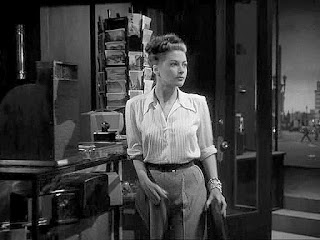
Criss Cross is also a very historic film, in the sense that it shows many Los Angeles locales as they were in the late 1940's...most notably, Angels Flight and Bunker Hill (both now gone, I believe), and a great look at Union Station as it was then. There is also a fun bit of dialogue between two characters discussing the price of groceries at the local market that should give those familiar with current prices pause...not to mention several indications of the nickel phone call and .25 cent beer".
Source: www.noiroftheweek.com

"Siodmak shoots the film from Steve's perspective (like a Raymond Chandler novel). That element makes it unlike the other Siodmak/Lancaster collaboration The Killers which is told in a Citizen-Kane type flashback. This point of view makes it hard to see Anna's faults even after Steve finds out (in a heartbreaking scene) that she'd run off to marry Slim. Siodmak uses the first person perspective effectively throughout the film especially at the end of the movie when Steve's recovering from a bullet wound and broken arm.


Special mention should be made about the bad guys in Criss Cross. Duryea is a perfect contrast to Lancaster. He's not just “slim” to Lancaster's beefiness. When Slim catches Steve with Anna in a key scene leading up to the heist Duryea's sporting an all black suit with a white tie while Lancaster is wearing a white t-shirt over light colored pants creating a perfect contrast. A suit – no matter how sharp – doesn't make a performance however. Duryea – the ultimate noir pimp and small-time criminal -is a key element in this unique love triangle".
Source: www.noiroftheweek.com

"Chandler’s fiction and Hawks’ films share this agnostic view of death, and it is just one of the points they have in common with a post-World War I phenomenon that includes Ernest Hemingway, Dashiell Hammett, Hecht and MacArthur; such lesser lights as John MacGavock Grider, Elliott White Springs, and John Monk Saunders; and, to a modest extent, William Faulkner and F. Scott Fitzgerald. Seen in these terms, Chandler and Hawks are part of a generation of storytellers whose works reflect the disillusionment of World War I and the cynicism of Prohibition while dramatizing a very modern and perhaps unprecedented reliance on personal style and integrity. Theirs is a personal ethics cut loose from traditional American optimism, but not from the American faith in the dignity of the individual.

At its most simplistic, it is part of the tough-but-sensitive syndrome; at its best, it includes the varieties of hard-pressed integrity embodied by Philip Marlowe in both versions of "The Big Sleep".
Source: parallax-view.org

Tom Neal and Ann Savage as Al Roberts and Vera in Detour (1945) directed by Edgar G. Ulmer

"Detour is a masterpiece of wry perversity, a film virtually constructed on irony and paradox: an incredibly claustrophobic film about hitchhiking on the “open road”; the bleakest of films noirs, with the bulk of the action taking place during the day and away from the city. But perhaps the supreme ironies relate to the film itself. Detour somehow speaks directly and compellingly to the dark side of several pervasive American myths, forcefully expresses a coherent vision of the way the world operates".
Source: parallax-view.org

Barbara Stanwyck as Phyllis Dietrichson in "Double Indemnity" (1944) directed by Billy Wilder

"Double Indemnity has to be number one. And if you’ve seen Double Indemnity, I don’t think you have to see The Postman Always Rings Twice… they’re kind of the same movie in a way. Out of the Past, Criss-Cross with Burt Lancaster and Yvonne DeCarlo – Criss Cross is like the pinnacle of Noir in a lot of ways; I really like The Asphalt Jungle;

and my personal favorite is In a Lonely Place, which is not what people expect out of a Film Noir, but I can’t leave it off of any list. It’s my favorite film, period. That pretty much does it. Of course, there are other great films…I absolutely love Sunset Boulevard, for one…but if it’s only five films, I don’t want to put two Billy Wilder films on the list [laughs]
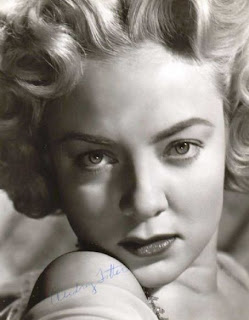
-You also struck up a friendship with Audrey Totter. She’s one of my favorite leads in some of these Noirs. I love her in The Set-Up, and have you seen her in The Unsuspected?
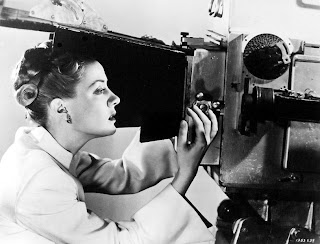
-Oh, yeah! She’s great. Now, she is the example of an actress who’s the complete antithesis of what she plays on the screen. She was by far the sweetest, most conscientious, nicest of the women I interviewed for Noir City Dames. They were all very nice, but Audrey was extremely nice".
Source: thesunbreak.com

“Noir is premised on the audience’s need to see failure risked, courted, and sometimes won; the American dream becomes a nightmare, one strangely more seductive and euphoric than the optimism it repudiates… Noir provided losing with a mystique.”
-Ann Douglas in the noir issue of Vanity Fair (March 2007)

Audrey Totter sits with Dan Duryea (two classic villains on screen)
-"In this series we have Raymond Burr and William Conrad, we’ve got Richard Widmark and Dan Duryea, who is my favorite noir weasel of all time and also makes for a very interesting good guy in those rare roles. But the noir icon who is the most unlikely of noir icons and yet still one of my favorites, you have two films with Dick Powell. How did this former light romantic lead and musical comedy star become such an effective, deadpan, everyman noir hero?

Dick Powell and Rhonda Fleming as Rocky and Nancy in "Cry Danger" (1951) directed by Robert Parrish

Dick Powell, technical advisor John P. Barrett and Humphrey Bogart on the set of "Johnny O'Clock" (1947) directed by Robert Rossen
-That’s a really good question. I don’t think it was an easy transition for him.

-By the time he’s making
Cry Danger, he has perfected it, because his performance in
Cry Danger is as good a laconic, wise-cracking, tough guy performance as anybody has given in film noir. And it took him a few years to get there. I think Dick Powell is a really interesting character because, to me, he’s a little bit like Joan Crawford in that they understood their image completely and then they got into production.

Claire Trevor and Dick Powell as Helen Grayle and Philip Marlowe in "Murder My Sweet" (1944) directed by Edward Dmytryk
-Dick Powell has become a very important figure in relation to the work of the Film Noir Foundation because he produced so many films himself. He wanted to be independent, he wanted to cut the studio out of the equation because he was tired of the studios overlooking him for parts that he wanted to play, like Double Indemnity, for example. He finally said, “Well, the hell with them, if they’re not going to give me the parts, I’m going to produce the films myself and star in them.” And so Pitfall and Cry Danger and Split Second, which he directed, he wasn’t in it, and there are several other films escaping me at the moment, right in that period, which he produced.

Dennis O'Keefe and Ann Sheridan in "Woman on the Run" (1950)

Dennis O'Keefe learns the mechanics of knitting from his co-star Marsha Hunt during the filming of "Raw Deal" (1948)

-In Raw Deal he makes that guy completely terrifying.
-Yeah. And this is what is so great about Dennis O’Keefe. He goes from being the best wisecracking pal to being a really, really scary noir guy effortlessly. He’s just great at it. You’ll see in Walk a Crooked Mile. It’s kind of a lame role but, man, O’Keefe is just so great on screen, his patter and his ease on screen is so incredible that you can’t take your eyes off him.

-I discovered O’Keefe in a film noir series I did in the mid-eighties in college, an entire term of Sunday night double features. I was programming things that I could not see on video back in the mid 1980s, so I got all the Anthony Mann noirs out of the Kit Parker catalogue and saw Raw Deal and it knocked my socks off. It was tough and spooky and hard-edged and visually stunning and it was made on nothing.
-It’s all style and guile".
Source: parallax-view.org
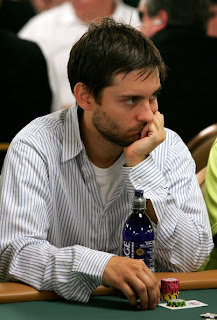 Tobey Maguire -who will be playing Nick Carraway in The Great Gatsby (2012), directed by Baz Luhrmann, acting as the narrator, a graduate from Yale in this adaptation of F. Scott Fitzgerald's novel- competed on the first day of the World Series of Poker no-limit Texas Hold 'em at the Rio Hotel & Casinoon 28th July, 2006 in Las Vegas, Nevada. Over 8,500 players joined the event. The final nine players competed for the top prize of more than USD 11.5 million on the final table. Maguire survived days 1a, 2a and 3 but was eliminated in 292nd place on the fourth day, taking $39,445 in prize money.
Tobey Maguire -who will be playing Nick Carraway in The Great Gatsby (2012), directed by Baz Luhrmann, acting as the narrator, a graduate from Yale in this adaptation of F. Scott Fitzgerald's novel- competed on the first day of the World Series of Poker no-limit Texas Hold 'em at the Rio Hotel & Casinoon 28th July, 2006 in Las Vegas, Nevada. Over 8,500 players joined the event. The final nine players competed for the top prize of more than USD 11.5 million on the final table. Maguire survived days 1a, 2a and 3 but was eliminated in 292nd place on the fourth day, taking $39,445 in prize money. In "Casino Royale" (2006) there are thrilling adventures and romance amidst rounds of poker culminating in an engrossing high-stakes poker game in Montenegro. In a fight scene Vesper “Money Penny” Lynd (Eva Green) assists James in helping to beat one of the villains.
In "Casino Royale" (2006) there are thrilling adventures and romance amidst rounds of poker culminating in an engrossing high-stakes poker game in Montenegro. In a fight scene Vesper “Money Penny” Lynd (Eva Green) assists James in helping to beat one of the villains. The pace changes when Bond meets the Treasury's Vesper Lynd (Eva Green) ahead of a poker game against an international money launderer Le Chiffre. Eva Green is a great asset in "Casino Royale", first reluctant to get involved with Bond, and later helping him in eloquent manners. She subverts Bond girl cliches and gives us a female character bluffing her way through poker and later a love story.
The pace changes when Bond meets the Treasury's Vesper Lynd (Eva Green) ahead of a poker game against an international money launderer Le Chiffre. Eva Green is a great asset in "Casino Royale", first reluctant to get involved with Bond, and later helping him in eloquent manners. She subverts Bond girl cliches and gives us a female character bluffing her way through poker and later a love story.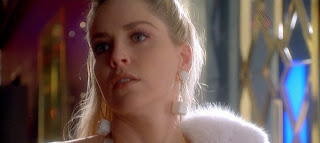 Sharon Stone as Ginger McKenna in "Casino" (1995).
Sharon Stone as Ginger McKenna in "Casino" (1995). Based on the book by Larry Shandling and Nicholas Pileggi, "Casino" was directed by Martin Scoresese, starring Robert De Niro as Sam "Ace" Rothstein, a character based on Frank Rosenthal, who ran casinos in Las Vegas in the 70’s, most notably the Stardust casino (gambling, poker games, etc.)
Based on the book by Larry Shandling and Nicholas Pileggi, "Casino" was directed by Martin Scoresese, starring Robert De Niro as Sam "Ace" Rothstein, a character based on Frank Rosenthal, who ran casinos in Las Vegas in the 70’s, most notably the Stardust casino (gambling, poker games, etc.) Jodie Foster plays in "Maverick" (1994) a scheming southern belle and a skillful poker player. Bret Maverick (Mel Gibson) is attempting to enter a five-card draw tournament to prove that he is the best poker player. He needs an additional $3,000 to participate in the $25,000 event. In the town of Crystal Rivers he meets two other poker players: Foster’s Annabelle and Angel, played by Alfred Molina.
Jodie Foster plays in "Maverick" (1994) a scheming southern belle and a skillful poker player. Bret Maverick (Mel Gibson) is attempting to enter a five-card draw tournament to prove that he is the best poker player. He needs an additional $3,000 to participate in the $25,000 event. In the town of Crystal Rivers he meets two other poker players: Foster’s Annabelle and Angel, played by Alfred Molina. The tournament hits a high point when it’s down to three players: Maverick, Angel and The Commodore: While the odds of Gibson’s Ace of Spades draw are low (52 cards in a deck) the Commodore has four of a kind (eights) and Angel has a low straight flush. In the third act, the poker fans will be delighted since the interactions are all secondary to the poker action, which is some of the best captured on film.
The tournament hits a high point when it’s down to three players: Maverick, Angel and The Commodore: While the odds of Gibson’s Ace of Spades draw are low (52 cards in a deck) the Commodore has four of a kind (eights) and Angel has a low straight flush. In the third act, the poker fans will be delighted since the interactions are all secondary to the poker action, which is some of the best captured on film. Paul Newman playing poker in "The Sting" (1973)
Paul Newman playing poker in "The Sting" (1973) After Henry Gondorf (Paul Newman) and John Hooker (Robert Redford) spot Doyle Lonnegan (Robert Shaw), a high-stakes gambler during a poker game, they come up with a cunning method of manipulating him into placing sure bets on fixed horse races.
After Henry Gondorf (Paul Newman) and John Hooker (Robert Redford) spot Doyle Lonnegan (Robert Shaw), a high-stakes gambler during a poker game, they come up with a cunning method of manipulating him into placing sure bets on fixed horse races. "The Sting" on Top 250 #99 in Imdb List won 7 Oscars in 1974 - Best Picture, Best Director: George Roy Hill, Best Writing, Story and Screenplay Based on Factual Material or Material Not Previously Published: David S. Ward, Best Film Editing: William Reynolds, Best Music, Scoring Original Song Score and/or Adaptation, Best Art Direction-Set Decoration, Julia Phillips became the first female producer to win the Best Picture category.
"The Sting" on Top 250 #99 in Imdb List won 7 Oscars in 1974 - Best Picture, Best Director: George Roy Hill, Best Writing, Story and Screenplay Based on Factual Material or Material Not Previously Published: David S. Ward, Best Film Editing: William Reynolds, Best Music, Scoring Original Song Score and/or Adaptation, Best Art Direction-Set Decoration, Julia Phillips became the first female producer to win the Best Picture category. The incorporation of gambling, casinos, poker and other games in movies goes all the way back to the 1930's with "Gambling Lady" starring Barbara Stanwyck.
The incorporation of gambling, casinos, poker and other games in movies goes all the way back to the 1930's with "Gambling Lady" starring Barbara Stanwyck. Yvonne de Carlo and Dan Duryea playing the roulette in "River Lady" (1948) directed by George Sherman
Yvonne de Carlo and Dan Duryea playing the roulette in "River Lady" (1948) directed by George Sherman Dan Duryea, the onetime advertising copywriter turned actor, became synonymous with a particularly decadent and insidious form of evil, Catch "Criss Cross" (1949) for a prototypical Duryea performance as Slim Dundee, a well-dressed gambler and syndicate boss who could teach Dennis Hopper a few tricks about sneering with nasty intent.
Dan Duryea, the onetime advertising copywriter turned actor, became synonymous with a particularly decadent and insidious form of evil, Catch "Criss Cross" (1949) for a prototypical Duryea performance as Slim Dundee, a well-dressed gambler and syndicate boss who could teach Dennis Hopper a few tricks about sneering with nasty intent. Duryea reserves his most chilling glares for Steve Thompson (Burt Lancaster), the viral, young buck one married to Dundee's wife, Anna (Yvonne De Carlo) Sultry Anna longs to burn again in Steve's arms, but how can she manage without the money from her sugar daddy Slim?
Duryea reserves his most chilling glares for Steve Thompson (Burt Lancaster), the viral, young buck one married to Dundee's wife, Anna (Yvonne De Carlo) Sultry Anna longs to burn again in Steve's arms, but how can she manage without the money from her sugar daddy Slim? Accessing this site you can enjoy playing poker online which offers you the most number of online poker games, with continuous tournaments starting. Through Internet you can enjoy one of the largest poker directories, featuring reviews of the best strategies and qualify for live events.
Accessing this site you can enjoy playing poker online which offers you the most number of online poker games, with continuous tournaments starting. Through Internet you can enjoy one of the largest poker directories, featuring reviews of the best strategies and qualify for live events. One of their sections is PokerStars Women exclusively designed for female poker players, offering a variety of schemes and exclusive tournaments.
One of their sections is PokerStars Women exclusively designed for female poker players, offering a variety of schemes and exclusive tournaments.





